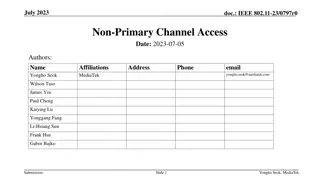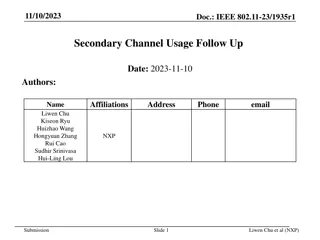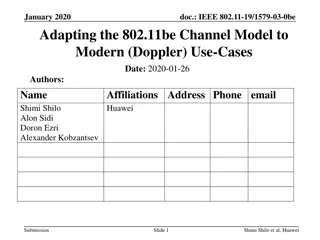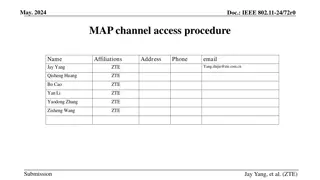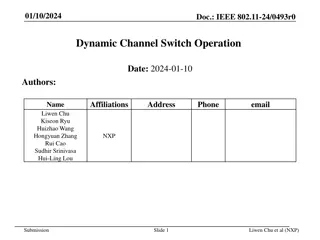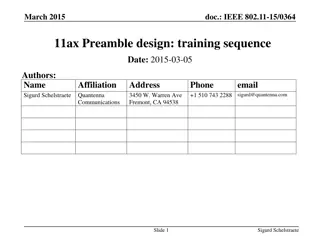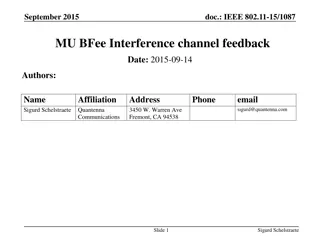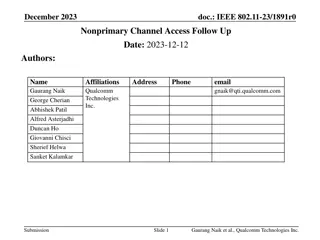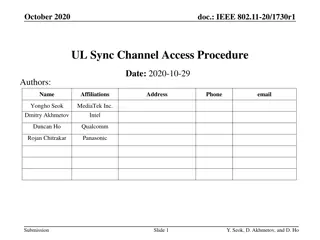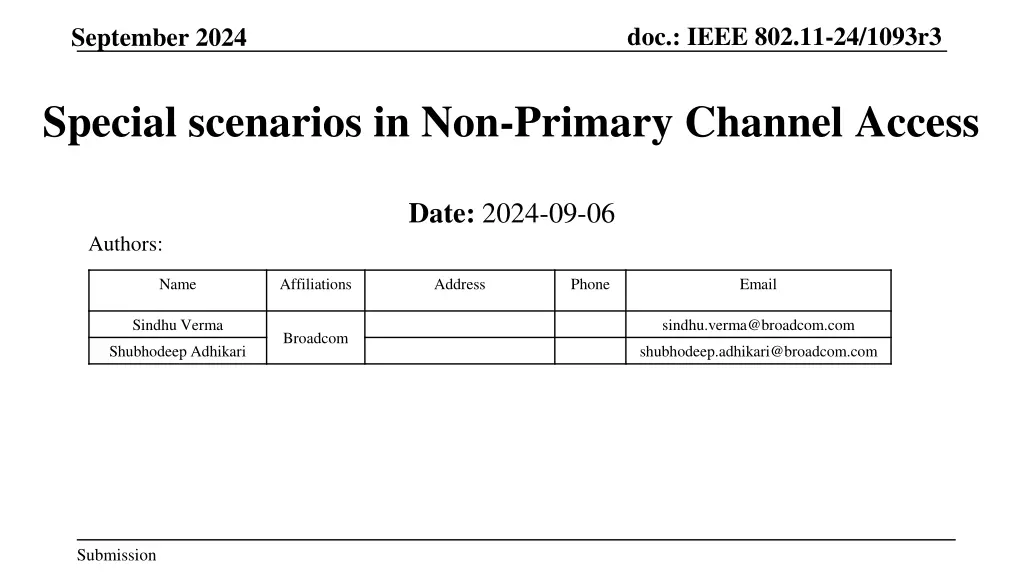
Special Scenarios in Non-Primary Channel Access for IEEE 802.11-24/1093r3 September 2024
"Explore special scenarios and mitigation strategies for Non-Primary Channel Access in IEEE 802.11-24/1093r3 September 2024. Discusses scenarios like overlapping OBSS transmissions and mechanisms to mitigate errors. Presented by Sindhu Verma and Shubhodeep Adhikari from Broadcom."
Download Presentation

Please find below an Image/Link to download the presentation.
The content on the website is provided AS IS for your information and personal use only. It may not be sold, licensed, or shared on other websites without obtaining consent from the author. If you encounter any issues during the download, it is possible that the publisher has removed the file from their server.
You are allowed to download the files provided on this website for personal or commercial use, subject to the condition that they are used lawfully. All files are the property of their respective owners.
The content on the website is provided AS IS for your information and personal use only. It may not be sold, licensed, or shared on other websites without obtaining consent from the author.
E N D
Presentation Transcript
doc.: IEEE 802.11-24/1093r3 September 2024 Special scenarios in Non-Primary Channel Access Date: 2024-09-06 Authors: Name Affiliations Address Phone Email Sindhu Verma sindhu.verma@broadcom.com Broadcom Shubhodeep Adhikari shubhodeep.adhikari@broadcom.com Submission
doc.: IEEE 802.11-24/1093r3 September 2024 Introduction This contribution is a follow-up of the contributions 11-23/2023r1, 11-23/0034r1 and 11-23/1288r0 on non-primary channel access for 11bn. The following motion on NPCA was agreed in the TGbn meeting on May/2024: TGbn defines a mode of operation that enables a STA to access the secondary channel while the primary channel is known to be busy due to OBSS traffic or other TBD conditions. The mode of operation shall not assume that the STA is capable to detect or decode a frame and obtain NAV information of the secondary channel concurrently with the primary channel. A BSS shall only have a single NPCA primary channel (name TBD) on which the STA contends while the primary channel of the BSS is known to be busy due to OBSS traffic or other TBD conditions. NPCA being a major departure from the legacy operation of 802.11, at least the initial design needs to consider mechanisms to avoid error scenarios. This contribution discusses various scenarios that are possible in NPCA with the assumption that there is a single NPCA primary channel It also discusses mechanisms to mitigate any error conditions Sindhu Verma et al., Broadcom Submission Slide 2
doc.: IEEE 802.11-24/1093r3 September 2024 Special scenarios possible in NPCA (1) Scenario 1: While receiving an OBSS transmission on the primary channel, an OBSS transmission also occurs on the NPCA primary channel This is possible in the presence of a) OBSSs with unaligned primary channels or b) OBSSs that use NPCA. This may result in loss of medium synchronization on the NPCA primary channel. Similar scenarios arise in legacy configurations too in the presence of OBSSs with unaligned primary channels and additionally for multi-link in 11be. Mitigation procedures: A conservative CCA mechanism on the NPCA primary channel to mitigate the impact of any loss in medium synchronization Triggered-only UL transmission on the NPCA primary channel or even on the primary channel Sindhu Verma et al., Broadcom Submission Slide 3
doc.: IEEE 802.11-24/1093r3 September 2024 Special scenarios possible in NPCA (2) Scenario 2: While receiving an OBSS transmission on the NPCA primary channel, an OBSS transmission also occurs on the primary channel This is possible when the following events happen: NPCA AP/non-AP receives an OBSS transmission on the primary channel and moves to the NPCA primary channel NPCA AP/non-AP then receives an OBSS transmission on the NPCA primary channel While receiving the OBSS transmission on the NPCA primary channel another OBSS transmission occurs on the primary channel. Note: a) the overlapping OBSS transmissions on the primary channel have to be from OBSS nodes that are hidden from each other b) Even if the NPCA device had not moved and stayed on the primary channel, it may not have been able to correctly receive the overlapping OBSS transmissions c) The OBSS transmission on the NPCA primary channel has to be either from an OBSS with unaligned primary or from an OBSS that uses NPCA. Mitigation procedures: This occurrence too can be reduced by having triggered-only UL transmission on the NPCA primary channel or even on the primary channel Sindhu Verma et al., Broadcom Submission Slide 4
doc.: IEEE 802.11-24/1093r3 September 2024 Special scenarios possible in NPCA (3) Scenario 3: An NPCA device sees an OBSS transmission on the primary channel or sees the primary channel as idle and during it, a transmission for itself also occurs on the NPCA primary channel. Hence, this scenario requires hidden nodes and is rare even then. This is possible if the following events happen: Sequence 1: NPCA AP sees an OBSS on the primary channel that an NPCA non-AP does not see. NPCA AP moves to the NPCA primary channel, finishes backoff and starts transmitting to the NPCA non-AP. NPCA non-AP stays on the primary or just then, the NPCA non-AP sees an OBSS on the primary channel which the serving UHR NPCA AP does not see and starts decoding it Sequence 2: NPCA non-AP sees an OBSS on the primary channel that the NPCA AP does not see NPCA non-AP moves to the NPCA primary channel, finishes backoff and starts transmitting to the NPCA AP NPCA AP stays on the primary or just then, the NPCA AP sees an OBSS on the primary channel which its NPCA non-AP does not see and starts decoding it Mitigation procedures: Triggered only UL on the NPCA primary channel. This is also because the number of non-APs is typically higher and hence, there is a higher chance of a non-AP winning channel access and transmitting. Sindhu Verma et al., Broadcom Submission Slide 5
doc.: IEEE 802.11-24/1093r3 September 2024 Special scenarios possible in NPCA (4) Scenario 4: An NPCA device sees an OBSS transmission on the NPCA primary channel and during it, a transmission for itself also occurs on the primary channel. This is possible if the following happen: Sequence 1: Sequence 2: This scenario too requires hidden nodes. Typically, the transmissions on the primary channel on top of the already detected OBSS by the AP or non-AP would be in error or at least not responded to. It is similar to the case of hidden node in legacy operation. Such events may still adversely impact the CW and rate control at the transmitter. Mitigation procedures Triggered only UL for NPCA non-APs and legacy non-APs on the primary channel. The number of non-APs is typically higher and hence, there is a higher chance of a non-AP winning channel access and transmitting. NPCA AP sees an OBSS on the primary channel that an NPCA non-AP does not see. NPCA AP moves to the NPCA primary channel and possibly also, sees another OBSS transmission Just then, the NPCA non-AP or a legacy non-AP starts transmitting to the NPCA AP. NPCA non-AP sees an OBSS on the primary channel that the UHR NPCA AP does not see NPCA non-AP moves to the NPCA primary channel and possibly also, sees another OBSS transmission Just then, the NPCA AP starts transmitting to the NPCA non-AP Sindhu Verma et al., Broadcom Submission Slide 6
doc.: IEEE 802.11-24/1093r3 September 2024 Special scenarios possible in NPCA (5) Scenario 5: An NPCA devices sees a transmission on the NPCA primary channel and at the same time it s backoff expires on the primary channel This is a race condition. The most obvious resolution is to act on backoff expiry on the primary channel However, this behavior can lead to some error conditions as below, if untriggered UL transmissions are allowed A transmission is initiated by an AP on the primary channel and a non-AP transmits to the AP on the NPCA primary channel: A non-AP could have transmitted to the AP on the NPCA primary channel after detecting a hidden OBSS on the primary channel, while backoff expired on the primary channel for the AP which then transmits to the same non-AP on the primary channel A transmission is initiated by an AP on the NPCA primary channel and a non-AP transmits to the AP on the primary channel: An AP could have transmitted to the non-AP on the NPCA primary channel after detecting a hidden OBSS on the primary channel, while backoff expired on the primary channel for the non-AP which then transmits to the AP on the primary channel These can again be mitigated by allowing triggered-only UL transmissions on the NPCA channel and the primary channel (if NPCA is enabled), even if it may not amount to successful receptions Sindhu Verma et al., Broadcom Submission Slide 7
doc.: IEEE 802.11-24/1093r3 September 2024 Special scenarios possible in NPCA (6) Scenario 6: A transmission is initiated by one non-AP on the NPCA primary channel and a transmission is initiated by another non-AP on the NPCA primary channel. The two non-APs are either hidden from each other or their backoff counters expired within the difference of a few slots This is mitigated by triggered-only UL transmissions on the NPCA primary channel Scenario 7: A transmission is initiated by one non-AP on the primary channel and a transmission is initiated by another non-AP on the NPCA primary channel. The OBSS seen by the second non-AP is hidden from the first non-AP and their backoff counters expired within the same TXOP The probability of this can be high in the presence of multiple non-APs. This is mitigated by triggered-only UL transmissions on the NPCA primary channel and the primary channel (if NPCA is enabled). Sindhu Verma et al., Broadcom Submission Slide 8
doc.: IEEE 802.11-24/1093r3 September 2024 Special scenarios possible in NPCA (7) Scenario 8: Backoff expires on the NPCA primary channel while the primary channel is idle and its backoff hasn t expired, and then the primary channel becomes occupied The backoff on the NPCA primary channel needs to be redrawn Scenario 9: A preamble or data reception occurs on the primary channel and the backoff expires on the NPCA primary channel The backoff counter on the NPCA primary channel will need to be redrawn The device in question needs to first decode the preamble on the primary channel and ascertain if it is meant for itself After that it can restart the backoff counter on the NPCA primary channel or continue with the reception on the primary channel Sindhu Verma et al., Broadcom Submission Slide 9
doc.: IEEE 802.11-24/1093r3 September 2024 Summary of error conditions It can be seen in the description so far, that sources of error conditions in most cases are as follows: Hidden OBSSs (different views at the AP and at non-APs) Mutually hidden non-APs Multiple non-APs with the same AP The error conditions are compounded by Untriggered UL transmissions on the primary channel or the NPCA primary channel The after effects of these are: Loss of data packets CW increase Poor rate control Excessive retransmissions Sindhu Verma et al., Broadcom Submission Slide 10
doc.: IEEE 802.11-24/1093r3 September 2024 Mitigation methods MU-EDCA on the primary channel for UHR and pre-UHR non-APs, especially in case of multiple associated non- APs MU-EDCA-linked scheme on the NPCA primary channel for UHR non-APs, especially in case of multiple associated non-APs. The AP can choose to enable/disable such a mode. This should be partly independent of the non-APs MU- EDCA state machine on the primary channel. For example, Untriggered UL transmissions disabled on the NPCA primary channel A triggered UL transmission on the primary channel or NPCA primary channel should reset the MU-EDCA state machine on the primary channel However, expiry of MU-EDCA timer on the primary channel should not cause untriggered UL transmission on the NPCA primary channel A designated initial control frame at the beginning of every initiated TXOP on the primary channel or the NPCA primary channel If the response to the initial control frame directed to an NPCA STA is not received, conservative action at the originator with regards to retransmissions or rate control (assuming that the absence could be because of loss of synchronization on the primary or NPCA primary channel due to hidden nodes) Sindhu Verma et al., Broadcom Submission Slide 11
doc.: IEEE 802.11-24/1093r3 September 2024 Conditions for attempting transmission on the NPCA primary channel (1) In the following discussion, it is assumed that ICF is in non-HT duplicate while ICR can be in non-HT or a TB PPDU. Receiving both OBSS ICF and OBSS ICR in non-HT duplicate: The ICF carries the OBSS identification. It also carries bandwidth information if it is BSRP/MU-RTS or an RTS with bandwidth signaling TA. BSRP/MU-RTS also carry the exact 320MHz channel that is being used. Hence, detecting an RTS with 320MHz bandwidth should never amount to attempting transmission on the NPCA primary channel. For the cases where inferred bandwidth information support switching to the NPCA primary channel, any subsequent ICR confirms to the NPCA device that the OBSS TXOP has continued. So, once the ICR is detected, an NPCA device does not need to check if the ICR is from an OBSS or its bandwidth. It is sufficient for an NPCA device to decode the non-HT preamble of the ICR within SIFS gap. Sindhu Verma et al., Broadcom Submission Slide 12
doc.: IEEE 802.11-24/1093r3 September 2024 Conditions for attempting transmission on the NPCA primary channel (2) Receiving OBSS ICF in non-HT duplicate and OBSS ICR in TB PPDU: Here too, the ICF carries the OBSS identification and bandwidth information. Similar to the previous condition, once the presence of ICR is detected, an NPCA device does not need to check if the ICR is from an OBSS or its bandwidth. It is sufficient for an NPCA device to decode the non-HT preamble of the ICR within SIFS gap. Receiving only OBSS ICR in non-HT duplicate: The ICR in non-HT duplicate can either be a CTS or M-STA-BA. If it s an M-STA-BA, we can require that it indicate bandwidth in a scrambling sequence and/or in the MAC header. It can also indicate OBSS information. If it's a CTS, there is no direct procedure to infer its OBSS nature and bandwidth. An AP can infer OBSS nature of the CTS if the MAC address is not from a device it is associated with. For a non-AP, it is more difficult to infer the OBSS nature. Neither the AP nor the non-AP can conclusively detect the bandwidth Hence, detecting only CTS without the preceding ICR should not result in attempting transmission on the NPCA primary channel Sindhu Verma et al., Broadcom Submission Slide 13
doc.: IEEE 802.11-24/1093r3 September 2024 Conditions for attempting transmission on the NPCA primary channel (3) Receiving OBSS ICF in non-HT duplicate + gap + OBSS PPDU Once the OBSS ICF is detected, the subsequent PPDU within the timeout period can be of any type, and not necessarily HE/EHT/UHR, as the OBSS nature of the TXOP is already determined from the ICF. On detection of the PPDU after the gap, the NPCA session can be as long as that set by the ICF. A timeout condition for cancelling NAV is needed after detecting the OBSS ICF. If the ICR is not sent or is not decodable at the NPCA device, a way to ascertain if the TXOP has continued is by waiting for a PPDU reception within the timeout. One also needs to consider cases where the OBSS ICF-ICR is a BSRP-BSR or a BSRP-M-STA-BA exchange or a CBF sequence. In this case, a timeout equal to CTS timeout will not suffice. The timeout value can be ICR_time (indicated in the OBSS ICFs or advertised) Receiving only OBSS PPDU: An NPCA device needs to decode the HE-SIG-A for HE PPDUs or the U-SIG for EHT/UHR PPDUs to conclude that it is from an OBSS. If the PPDU is pre-HE, an NPCA device can use the MAC address of the first MPDU to conclude if the PPDU is from an OBSS. Sindhu Verma et al., Broadcom Submission Slide 14
doc.: IEEE 802.11-24/1093r3 September 2024 Conclusions This contribution discusses multiple special scenarios that can occur in an NPCA deployment and methods to mitigate any error conditions. One of the methods is to maximize triggered-only UL transmissions on the NPCA primary channel as well as the primary channel The mode where only triggered UL transmissions are allowed on the NPCA can be enabled/disabled by the AP Additionally, it is also preferable that all transmissions on the NPCA primary channel or primary channel commence with an initial control frame and response exchange. Further, since the absence on the NPCA primary channel or primary channel could be due to loss of synchronization between an AP and non-AP on the visibility of OBSS, conservative reaction to failure of initial control frame exchange is needed in terms of rate control or retransmission attempts The behaviour of backoff counters on the NPCA primary channel and primary channel is also discussed Conditions for attempting transmission on the NPCA primary channel were also discussed in terms of the OBSS activity detected on the primary channel. Sindhu Verma et al., Broadcom Submission Slide 15
doc.: IEEE 802.11-24/1093r3 September 2024 Straw Poll 1 Do you agree to define a mode of operation in NPCA where the NPCA non-AP does not use untriggered UL transmissions on the NPCA primary channel This mode can be enabled/disabled by the AP Whether the mode is for all associated non-APs or per non-AP is TBD TBD whether MU EDCA parameters mechanism is used for this or not Y/N/A Sindhu Verma et al., Broadcom Submission Slide 16
doc.: IEEE 802.11-24/1093r3 September 2024 Straw Poll 2 Do you agree with the following An NPCA STA shall initiate frame exchange on the NPCA Primary channel with an NPCA Initial Control Frame in the non-HT PPDU or non-HT duplicate PPDU format using a rate of 6 Mb/s, 12 Mb/s, or 24 Mb/s Details on NPCA ICF are TBD Y/N/A Sindhu Verma et al., Broadcom Submission Slide 17
doc.: IEEE 802.11-24/1093r3 September 2024 Straw Poll 3 Do you support the following in the NPCA operation? In 802.11bn, the event that triggers switching to the NPCA primary channel shall be OBSS Control frame exchange (e.g., (MU-)RTS/CTS) or OBSS HE/EHT/UHR PPDU Y/N/A Sindhu Verma et al., Broadcom Submission Slide 18
doc.: IEEE 802.11-24/1093r3 September 2024 Straw Poll 4 Do you agree that: if an NPCA STA receives an OBSS RTS frame in a non-HT duplicate PPDU that does not include the bandwidth signaling TA, the NPCA STA shall not switch to the NPCA Primary channel? if an NPCA STA receives an OBSS RTS frame in a non-HT duplicate PPDU that includes the bandwidth signaling TA and the signaled PPDU bandwidth is 320 MHz, the NPCA STA shall not switch to the NPCA Primary channel? if an NPCA STA receives a CTS frame in a non-HT duplicate PPDU without receiving the soliciting OBSS RTS or MU-RTS frame, the NPCA STA shall not switch to the NPCA Primary channel? Submission Y/N/A Sindhu Verma et al., Broadcom Slide 19
doc.: IEEE 802.11-24/1093r3 September 2024 Reference [1] IEEE P802.11be /D7.0 [2] 11-23/2023r1 Further discussion on Non-Primary Channel Access [3] 11-23/0034r1 Non Primary Channel Utilization [4] 11-23/1288r0 Non Primary Channel Utilization Follow-up [5] 11-20/0363r3 Non Primary Channel Utilization [6] 11-22/2204r0 Dynamic Subband Operation [7] 11-23/2141r0 Further discussion on Dynamic Subband Operation [8] 11-23/1875r0 Power save proposal for non-AP/mobile-AP [9] 11-23/1873r0 Post-FCS MAC padding Sindhu Verma et al., Broadcom Submission Slide 20



